The Old Mountain Turnpike
On the Rocks – The Woodstock Times
Updated by Robert and Johanna Titus
One of our region’s most historic roads is also one of its least known. It’s the Old Mountain Turnpike. Long ago, the road was the gateway to the Catskills. As far back as the 1820’s guests of the famed Catskill Mountain House Hotel took carriages up the pike to get to the hotel. As the hotel prospered, so did the turnpike. When the hotel got even more successful, it built the Otis Elevated Railway right up the Catskill Front, and the old dirt road slowly fell into disuse. Today the once great turnpike is just a horse and hiking trail, but it still has much of its 19th Century atmosphere. It makes a nice walk in the woods and, of course, along the way there are many rocks.
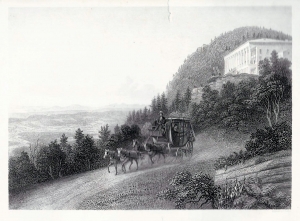
To get to the Old Mountain Turnpike take Rte. 23A into Palenville. Turn onto Bogart Road and head north to Mountain Turnpike Road where you turn left, the trailhead is at the western end of the road. You can hike all the way up to North Lake State Park if you like, or any part of the way. You don’t have to go far however before you are in the thick of the geology. The road climbs, makes a bend, and then a fine outcropping of reddish rocks appears. This is great Catskill Delta of the Devonian age. Such red strata are old floodplain deposits, silts and clays left by ancient floods and hardened into red shales. The darker deposits are the muds of delta backswamps. Away from the river channels, swamps formed in low-lying areas and those dark muds accumulated. Watch for fossil plant fragments in all of this.
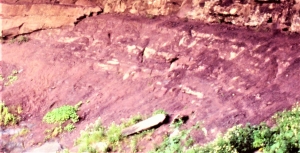
As you continue up the road you will encounter, at frequent intervals, a number of sandstone ledges. They are Devonian river channel deposits, composed mostly of sandy strata that dip one way or another. These are called cross beds and they are the products of ancient river currents. The river currents drove masses of sand into large “dunes” which migrated downstream. Most of those cross beds dip to the northwest as that was the direction that the old rivers flowed. In between the sandstone ledges the road tends to be pink or red. These are hidden floodplain deposits. The pattern is clear: river sands are followed by red floodplain shales and then more river sands and so on. The Catskill Front is like a great building, it’s made up of sandstone and shale “stories.” When we make such a hike, we almost always count those stories.
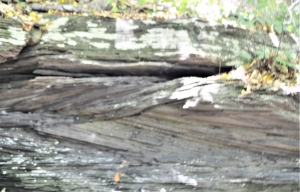
The second story had some prominent ripple marks in a layer of red shale that crossed the road. The ripples record breezes that blew across a shallow delta pond and generated currents that, in turn, created the ripples. Incredibly those ripples are the record of breezes of nearly 400 million years ago.
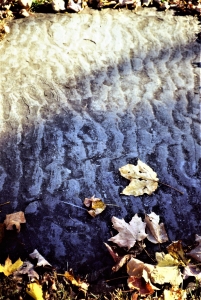
At the fourth story we found a vertical ledge of sandstone that had been scoured and striated by a passing glacier. This event occurred a mere 20,000 years ago. A twinkling of time compared to the age of the rocks themselves.
The 14th story was a massive sandstone. This must have been a very large river. Such rivers were what are called delta distributaries. In a large delta complex the trunk stream splits up into many such distributaries. Each one meanders back and forth across the delta plain. A river that is here today, may be gone tomorrow, replaced by a floodplain. That’s why these river sandstones alternate with red floodplain shales. Look at a map of the Mississippi Delta and you will see good examples of such distributaries. Then look at a map of the Ganges River Delta of Bangladesh and you will see even better examples.
The road ascended into a place called Sleepy Hollow and then made a sharp left bend. Here had once stood the Rip Van Winkle House; it had been the halfway stop for carriages headed up to the hotel. The hollow was naturally air conditioned with cool mountain breezed descending through it. It must have been a nice place to stop. But what impressed us most was just above, one of the largest, thickest stories of the hike. We thought that this must have been one of the greatest rivers of the Catskill Delta.
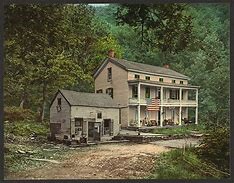
The 24th story brought us to a great overlook. The trees have been cleared away here and a picnic table set up. We ended our journey and sat and gazed out at the Hudson Valley. We had seen enough history for one day. We had watched as 24 Devonian rivers and one glacier had crossed this location. History is complex.
Contact the authors at randjtitus@prodigy.net. Join their facebook page “The Catskill
Geologist.”





